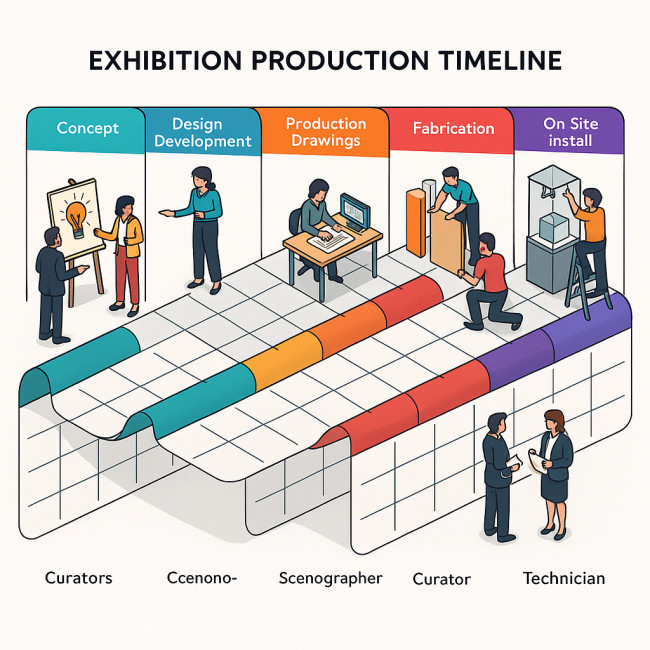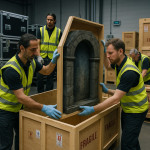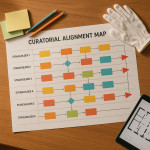Write crystal-clear briefs: secure flawless exhibition scenography deliverables
A watertight brief is the cheapest insurance policy you can buy for an exhibition. It aligns curators, scenographers and suppliers around the same narrative, budget and timeline. Follow this roadmap to write briefs that eliminate costly revisions and guarantee show-ready deliverables.
Why a crystal-clear brief saves time, money and nerves
Vague instructions translate into endless email threads, emergency overnights and a diluted visitor experience. A detailed exhibition scenography brief:
- Aligns every stakeholder on story, flow and technical constraints.
- Shrinks the revision loop because expectations are visible from day one.
- Locks the budget early, preventing scope creep that sabotages ROI.
- Speeds approvals with museums, insurers and fire-safety inspectors.
Professional studios listed on specialised spatial-design directories routinely reject projects that lack a robust brief—writing one is therefore your first act of talent attraction.
The nine indispensable sections of an exhibition scenography brief
1. Project vision & measurable objectives
Summarise the central story in one paragraph and translate it into smart metrics: target footfall, dwell time, or a merchandise uplift percentage.
2. Visitor personas and journey maps
Describe at least two persona archetypes and outline how they enter, circulate and exit the space. Pair each step with desired emotions—curiosity, awe, reflection.
3. Spatial constraints
- Floor plans (DWG or IFC)
- Ceiling load limits
- Power and data points
- Venue operational hours for build & strike
4. Narrative zones & content hierarchy
Break the exhibition into zones, list headline artifacts or media elements, and specify why each earns its square metre of real estate.
5. Technical specifications
Include luminance targets, acoustic criteria and media playback formats. For multi-sensory shows, reference coordination grid methodologies to keep supplier quotes comparable.
6. Sustainability requirements
More brands now request eco-smart material choices. State recycled content targets, modular build preferences and end-of-life plans to avoid late-stage redesigns.
7. Accessibility standards
List mandatory guidelines: ramp gradients, text contrast ratios and haptic alternatives. Early clarity here prevents future lawsuits and reinforces inclusive brand values.
8. Budget envelope
Split the total into design fees, build costs, AV rental and contingency. Firms reply faster when they know which creative solutions fit the purse.
9. Timeline and decision checkpoints
Assign approval owners and dates for concept, design development, production files and install. Penalise delays equally on both sides to keep momentum.
Sample timeline: from kick-off to opening night

The journey from a loose concept to a fully operational gallery space rarely follows a straight line, yet the milestones remain surprisingly universal. Visualising them as a segmented timeline helps every contributor stay conscious of downstream impacts: when the design team misses a storyboard review, production drawings lose a day, which in turn squeezes fabrication buffers and forces costly weekend labour. By mapping dependencies—such as material lead times, AV hardware rental windows, curator sign-off cycles and fire-safety submissions—into one panoramic view, you create an instant risk radar. Suppliers can flag clashes early, finance teams can schedule staged payments with confidence, and marketing can plan teaser campaigns that coincide with major build reveals. A timeline that compresses this web of dates into a single glance therefore operates as an executive dashboard, a staffing forecast and a morale booster rolled into one, making it a core attachment to any serious exhibition scenography brief.
| Phase | Duration | Key Deliverable |
|---|---|---|
| Concept Sprint | 2 weeks | Storyboards & mood boards |
| Design Development | 4 weeks | 3D model + material board |
| Production Drawings | 3 weeks | Shop drawings & cut files |
| Fabrication | 6 weeks | Pre-built modules ready for QA |
| On-site Install | 1 week | Snag-free, visitor-safe setup |
Toolbox: assets that turn words into unambiguous specs
- Annotated floor plans—colour code zones and visitor flows.
- SketchUp or REVIT exports—ensure geometry survives software hops.
- VR previews—reduce surprises; see how VR pre-visualisation pipelines cut revisions by half.
- Bill of materials (BOM)—itemise every panel, fastener and LED strip.
- Risk register—link each hazard to a mitigation action in your insurance checklist.
Writing tactics that sharpen every paragraph
- Use active verbs: “Install truss” reads clearer than “Truss to be installed.”
- Limit sentences to 25 words.
- Define acronyms on first use; even seasoned suppliers work across sectors.
- Pair qualitative goals with numbers: “Immersive” becomes “95 % of visitors spend at least 20 minutes inside.”
- Embed reference images with alt-text containers for universal comprehension.
Collaboration rituals that keep the brief alive
Once sent, a brief can stagnate. Keep it dynamic:
- Weekly stand-ups—10-minute calls prevent siloed misinterpretations.
- Change-log tracking—time-stamp edits; archive superseded versions.
- Decision logs—write the “why” behind every pivot to maintain institutional memory.
- Post-mortems—feed lessons into the next brief and nurture a culture of continuous improvement.
Common briefing pitfalls—and how to dodge them
- Scope creep: Add a “nice-to-have” column so extras stay visible but unfunded.
- Assumed knowledge: New freelancers may join mid-project. Attach a glossary.
- Late curator feedback: Insert mandatory story checkpoints aligned with curatorial alignment maps.
- Untracked file versions: Adopt cloud folders with granular permissions.
Quick self-check before you hit “send”
- Can a supplier quote without asking another question?
- Would a new team member grasp the narrative in five minutes?
- Is each requirement testable on site?
- Did you provide the budget and payment schedule?
Brief-writing quiz: test your readiness
FAQ
- How long should an exhibition scenography brief be?
- Aim for 8–12 pages plus annexes. Long enough to cover specifics, short enough to keep stakeholders reading.
- Which file formats do suppliers prefer?
- PDF for the narrative, DWG/IFC for plans, and XLSX or CSV for bills of materials.
- Can I update the brief after contracts are signed?
- Yes, but log every change, re-date the document and seek written acceptance to avoid disputes.
- What if my budget is still tentative?
- State a ±10 % range and list cost drivers so studios can propose phased options.
Key takeaway
Exhibition scenography briefs are not paperwork; they're project GPS devices. Craft yours with laser clarity and watch your concept glide from sketch to immersive, visitor-proof reality.
Ready to brief your next show? Borrow the structure above, adapt it to your story and contact top scenography talents today.











